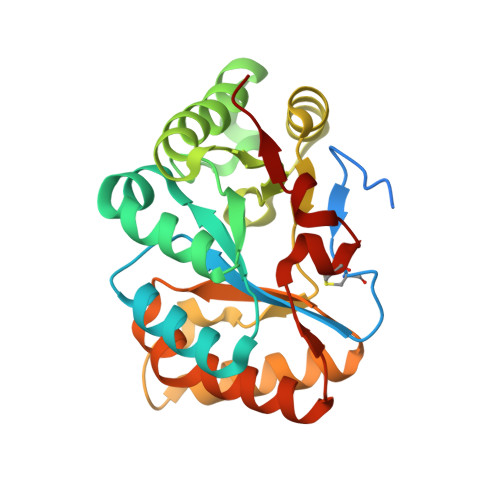In silico and in vitro analysis of an Aspergillus niger chitin deacetylase to decipher its subsite sugar preferences.
Bonin, M., Hameleers, L., Hembach, L., Roret, T., Cord-Landwehr, S., Michel, G., Moerschbacher, B.M.(2021) J Biol Chem 297: 101129-101129
- PubMed: 34478709
- DOI: https://doi.org/10.1016/j.jbc.2021.101129
- Primary Citation of Related Structures:
7BLY - PubMed Abstract:
Chitin deacetylases (CDAs) are found in many different organisms ranging from marine bacteria to fungi and insects. These enzymes catalyze the removal of acetyl groups from chitinous substrates generating various chitosans, linear copolymers consisting of N-acetylglucosamine (GlcNAc) and glucosamine. CDAs influence the degree of acetylation of chitosans as well as their pattern of acetylation, a parameter that was recently shown to influence the physicochemical properties and biological activities of chitosans. The binding site of CDAs typically consists of around four subsites, each accommodating a single sugar unit of the substrate. It has been hypothesized that the subsite preferences for GlcNAc or glucosamine units play a crucial role in the acetylation pattern they generate, but so far, this characteristic was largely ignored and still lacks structural data on the involved residues. Here, we determined the crystal structure of an Aspergillus niger CDA. Then, we used molecular dynamics simulations, backed up with a variety of in vitro activity assays using different well-defined polymeric and oligomeric substrates, to study this CDA in detail. We found that Aspergillus niger CDA strongly prefers a GlcNAc sugar unit at its -1 subsite and shows a weak GlcNAc preference at the other noncatalytic subsites, which was apparent both when deacetylating and N-acetylating oligomeric substrates. Overall, our results show that the combination of in vitro and in silico methods used here enables the detailed analysis of CDAs, including their subsite preferences, which could influence their substrate targets and the characteristics of chitosans produced by these species.
Organizational Affiliation:
University of Münster, Institute for Biology and Biotechnology of Plants, Münster, Germany.

















